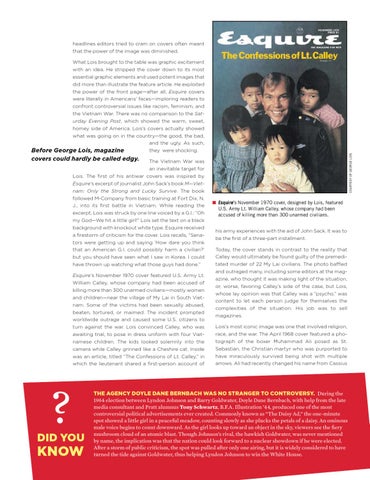headlines editors tried to cram on covers often meant that the power of the image was diminished. What Lois brought to the table was graphic excitement with an idea. He stripped the cover down to its most essential graphic elements and used potent images that did more than illustrate the feature article. He exploited the power of the front page—after all, Esquire covers were literally in Americans’ faces—imploring readers to confront controversial issues like racism, feminism, and the Vietnam War. There was no comparison to the Saturday Evening Post, which showed the warm, sweet, homey side of America. Lois’s covers actually showed what was going on in the country—the good, the bad, and the ugly. As such, they were shocking. George Lois, magazine The Vietnam War was an inevitable target for Lois. The first of his antiwar covers was inspired by Esquire’s excerpt of journalist John Sack’s book M—Vietnam: Only the Strong and Lucky Survive. The book followed M-Company from basic training at Fort Dix, N. J., into its first battle in Vietnam. While reading the excerpt, Lois was struck by one line voiced by a G.I.: “Oh my God—We hit a little girl!” Lois set the text on a black background with knockout white type. Esquire received a firestorm of criticism for the cover. Lois recalls, “Senators were getting up and saying ‘How dare you think that an American G.I. could possibly harm a civilian?’ but you should have seen what I saw in Korea. I could have thrown up watching what those guys had done.” Esquire’s November 1970 cover featured U.S. Army Lt. William Calley, whose company had been accused of killing more than 300 unarmed civilians—mostly women and children—near the village of My Lai in South Vietnam. Some of the victims had been sexually abused, beaten, tortured, or maimed. The incident prompted worldwide outrage and caused some U.S. citizens to turn against the war. Lois convinced Calley, who was awaiting trial, to pose in dress uniform with four Vietnamese children. The kids looked solemnly into the camera while Calley grinned like a Cheshire cat. Inside was an article, titled “The Confessions of Lt. Calley,” in which the lieutenant shared a first-person account of
?
DID YOU
KNOW
courtesy of george lois
Before covers could hardly be called edgy.
n Esquire’s November 1970 cover, designed by Lois, featured U.S. Army Lt. William Calley, whose company had been accused of killing more than 300 unarmed civilians. his army experiences with the aid of John Sack. It was to be the first of a three-part installment. Today, the cover stands in contrast to the reality that Calley would ultimately be found guilty of the premeditated murder of 22 My Lai civilians. The photo baffled and outraged many, including some editors at the magazine, who thought it was making light of the situation, or, worse, favoring Calley’s side of the case, but Lois, whose lay opinion was that Calley was a “psycho,” was content to let each person judge for themselves the complexities of the situation. His job was to sell magazines. Lois’s most iconic image was one that involved religion, race, and the war. The April 1968 cover featured a photograph of the boxer Muhammad Ali posed as St. Sebastian, the Christian martyr who was purported to have miraculously survived being shot with multiple arrows. Ali had recently changed his name from Cassius
The agency Doyle Dane Bernbach was no stranger to controversy. During the 1964 election between Lyndon Johnson and Barry Goldwater, Doyle Dane Bernbach, with help from the late media consultant and Pratt alumnus Tony Schwartz, B.F.A. Illustration ’44, produced one of the most controversial political advertisements ever created. Commonly known as “The Daisy Ad,” the one-minute spot showed a little girl in a peaceful meadow, counting slowly as she plucks the petals of a daisy. An ominous male voice begins to count downward. As the girl looks up toward an object in the sky, viewers see the fiery mushroom cloud of an atomic blast. Though Johnson’s rival, the hawkish Goldwater, was never mentioned by name, the implication was that the nation could look forward to a nuclear showdown if he were elected. After a storm of public criticism, the spot was pulled after only one airing, but it is widely considered to have turned the tide against Goldwater, thus helping Lyndon Johnson to win the White House. 23
